Politics
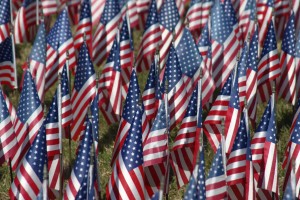 As we head into Independence Day 2020, many of us have begun to realize that this year, it’s different. Everything is different. The year, Independence Day has taken on a whole new meaning for me and so many others. For the first time in our nations history, almost everything was shut down. People were quarantined…leaving only the essential workers going to work, and the rest of us staying home, except for food, medicine, and doctor visits. Covid 19 had changed everything.
As we head into Independence Day 2020, many of us have begun to realize that this year, it’s different. Everything is different. The year, Independence Day has taken on a whole new meaning for me and so many others. For the first time in our nations history, almost everything was shut down. People were quarantined…leaving only the essential workers going to work, and the rest of us staying home, except for food, medicine, and doctor visits. Covid 19 had changed everything.
Spring Break for the schools brought the quarantine, and even if we had no children in school, we felt that change deeply. Everything just…stopped. Restaurants were closed, movies were out, bowling leagues ended early, as did all sports. Once the warmer weather hit, it felt like summer, but it was only May. This would prove to be the longest summer ever…I’m not complaining, mind you. Summer is my favorite time of year. I can’t imagine how awful it would have been, if the quarantine had happened in the Winter, when I wouldn’t have been able to get outside and walk on the trail near my home…especially since I am not into winter sports, and those places would have been closed anyway.
Finally after more than three months of quarantine, the states were allowed to begin reopening. Still, we did 
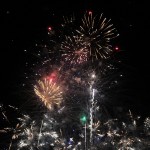 not know what the summer would look like. Sports were up in the air, contemplating a shortened season, or as in the case of some, cancelling the 2020 season altogether. Graduations, funerals, birthday gatherings, and holidays were uncertain. Finally, as campgrounds and hotels began to reopen, it looked like summer might be salvaged. Still, several fairs and some 4th of July fireworks thought about, or did cancel. My husband, Bob and I usually go to the Black Hills over the 4th of July, to do some hiking, so this was a concern to us. Finally, word came down that the fireworks display we loved would indeed be held, and that after a 9 year span without fireworks at Mount Rushmore, that display would also take place this year. We were so happy, and booked our motel right away.
not know what the summer would look like. Sports were up in the air, contemplating a shortened season, or as in the case of some, cancelling the 2020 season altogether. Graduations, funerals, birthday gatherings, and holidays were uncertain. Finally, as campgrounds and hotels began to reopen, it looked like summer might be salvaged. Still, several fairs and some 4th of July fireworks thought about, or did cancel. My husband, Bob and I usually go to the Black Hills over the 4th of July, to do some hiking, so this was a concern to us. Finally, word came down that the fireworks display we loved would indeed be held, and that after a 9 year span without fireworks at Mount Rushmore, that display would also take place this year. We were so happy, and booked our motel right away.
As we prepare to watch the fireworks on Independence Day 2020, it comes to mind that Independence Day has taken on a whole new meaning. For a time, we lost our independence, and now we have it back. The feeling  reminds me of how the early settlers felt, when England finally gave up and we had won our independence from them. Yes, we still have a ways to go before we will have our country back to normal. During the lock-down, some bad things happened and some people are in an outraged state, but I believe that we will be able to get back to normal through the love of God being shown in our nation. There are those who want to change the root of our nation, but they will not succeed. We are and always will be “One Nation, Under God” and we will have victory over the anarchists. Today, we celebrate the birth of our great nation, the United States of America. It is with a whole new meaning…Freedom Again!! Happy Independence Day everyone, God bless you all, and God bless America!!
reminds me of how the early settlers felt, when England finally gave up and we had won our independence from them. Yes, we still have a ways to go before we will have our country back to normal. During the lock-down, some bad things happened and some people are in an outraged state, but I believe that we will be able to get back to normal through the love of God being shown in our nation. There are those who want to change the root of our nation, but they will not succeed. We are and always will be “One Nation, Under God” and we will have victory over the anarchists. Today, we celebrate the birth of our great nation, the United States of America. It is with a whole new meaning…Freedom Again!! Happy Independence Day everyone, God bless you all, and God bless America!!
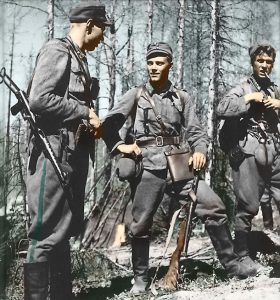 On June 26, 2003, a Green Beret was laid to rest at Arlington National Cemetery. That may not seem like such an unusual event, but in reality, it was very unusual. Lauri Allan Torni, aka Larry Thorne, was born in Viipuri, Finland on May 28, 1919. When he grew up, he entered the Finnish military service in 1938. He participated in the war between Finland and the USSR, proving himself in battle, and earning the rank of captain. It would appear that Torni would quite likely have a long and distinguished career in the military service.
On June 26, 2003, a Green Beret was laid to rest at Arlington National Cemetery. That may not seem like such an unusual event, but in reality, it was very unusual. Lauri Allan Torni, aka Larry Thorne, was born in Viipuri, Finland on May 28, 1919. When he grew up, he entered the Finnish military service in 1938. He participated in the war between Finland and the USSR, proving himself in battle, and earning the rank of captain. It would appear that Torni would quite likely have a long and distinguished career in the military service.
All that changed when Finland allied itself with Nazi Germany in 1941. In 1943, Torni put together a unit that was informally called Detachment Torni. This was an infantry unit that penetrated deep behind enemy lines, and they quickly made a reputation for themselves on both sides of the front for its combat effectiveness. For his part, Torni, for his Finnish military service was awarded 8 medals, to include the Mannerheim Cross, for action on July 9, 1944.
When his unit was demobilized, Torni joined a German SS unit in East Prussia and continued to fight the Russians, who at that time were the known enemy. During his time in the German SS, Torni was captured by the British, escaped a POW camp, and returned to Finland, where he was arrested for his German army service. I’m sure that at this point he wondered what was going on. I would think he realized the the German SS was his whole problem, but like many, he was fooled by Hitler and the Nazi party. After being pardoned in 1948, Torni secretly traveled to Sweden, masqueraded as a Swedish seaman, and sailed to the vicinity of Mobile, Alabama,  where he jumped overboard and made it to land. As most people know, getting to land was an opportunity to seek asylum, which Torni did. He was granted residency in 1953 and because he wanted to be loyal to his new country, Torni, now going by Larry Thorne joined the Army. Again, he proved himself in battle, and eventually became a Green Beret assigned to Special Forces. Torni, now Thorne was an incredible soldier, and very loyal to his nation and his fellow soldiers. He served in various high profile capacities around the world in his time of service as a Green Beret.
where he jumped overboard and made it to land. As most people know, getting to land was an opportunity to seek asylum, which Torni did. He was granted residency in 1953 and because he wanted to be loyal to his new country, Torni, now going by Larry Thorne joined the Army. Again, he proved himself in battle, and eventually became a Green Beret assigned to Special Forces. Torni, now Thorne was an incredible soldier, and very loyal to his nation and his fellow soldiers. He served in various high profile capacities around the world in his time of service as a Green Beret.
In 1963 when he was 44 years old, Thorne was deployed to Vietnam as an advisor, but two years later Torni’s remarkable career came to an end when his helicopter crashed during a secret mission. It was a tragic end to a short lived, be remarkable career. His remains were not located until 1999. Finally, on June 26, 2003, a multi-national hero and in the end, a celebrated Green Beret was laid to rest. He was an amazing soldier.
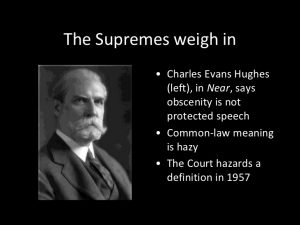 I sometimes think that I am from a different era…one where people didn’t use so many obscenities. In reality, I am from that era, because on June 24, 1957, when I was just a 14 months old, the United States Supreme Court ruled that obscenity is not protected by the First Amendment to the Constitution, which guarantees free speech and freedom of the press. Call me old fashioned, but when I hear someone screaming at their own child, using every obscenity known to man, it makes me cringe. Calling our children such horrible names, can’t possibly be a good way to teach them self esteem. The United States Supreme Court agreed, according to Roth v. United States, a case decided in 1957. Samuel Roth of New York City was convicted of mailing obscene materials. On appeal his conviction was affirmed by the Supreme Court, which held that obscenity was not protected by the First Amendment to the United States Constitution. The court ruled that “material is obscene if, to the average person applying contemporary community standards, the dominant overall theme appeals to prurient interest.”
I sometimes think that I am from a different era…one where people didn’t use so many obscenities. In reality, I am from that era, because on June 24, 1957, when I was just a 14 months old, the United States Supreme Court ruled that obscenity is not protected by the First Amendment to the Constitution, which guarantees free speech and freedom of the press. Call me old fashioned, but when I hear someone screaming at their own child, using every obscenity known to man, it makes me cringe. Calling our children such horrible names, can’t possibly be a good way to teach them self esteem. The United States Supreme Court agreed, according to Roth v. United States, a case decided in 1957. Samuel Roth of New York City was convicted of mailing obscene materials. On appeal his conviction was affirmed by the Supreme Court, which held that obscenity was not protected by the First Amendment to the United States Constitution. The court ruled that “material is obscene if, to the average person applying contemporary community standards, the dominant overall theme appeals to prurient interest.”
These days, we are bombarded with obscenities and profanities…everything from the f-bomb to the names we 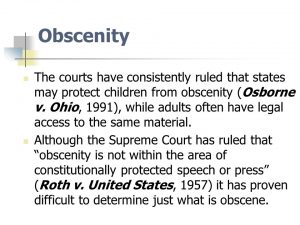 call people we don’t particularly like. Television shows use obscenities on just about every show, and our children are growing up to think that not only is it ok to call people such names, but its ok to be constantly angry…and to let everyone around you know it. It seems to me that as all the obscenities became commonplace, so did anger. And anger breeds hate, which in turn breeds things like road rage, bullying, and even murder.
call people we don’t particularly like. Television shows use obscenities on just about every show, and our children are growing up to think that not only is it ok to call people such names, but its ok to be constantly angry…and to let everyone around you know it. It seems to me that as all the obscenities became commonplace, so did anger. And anger breeds hate, which in turn breeds things like road rage, bullying, and even murder.
Now, that we have the freedom to say the things that we do, another problem has come to light…hate speech. What is hate speech? It never used to be a thing, although it did exist…it just didn’t have a name, per se. So we have somehow come full circle, to a degree. While the Supreme Court used to say that we can’t use obscenities or profanities, and then suddenly we could, now we find ourselves with the necessity to decide if something said is “hate speech” or not, and if it is, then has the right to free speech been denied. Why is one thing different than the other? Believe me, I don’t like either kind of talk…hate or obscene, but if one is “illegal” then shouldn’t the other also be “illegal.” Or, should we have any say at all? It is a vicious circle to be sure. I guess that in reality, it is a moral issue. We have slipped so far from the moral values of our ancestors that our 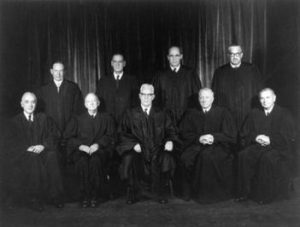 world almost doesn’t even resemble that of the era I was raised in, and certainly bears no resemblance to the era of our ancestors. While I can’t say exactly how to solve this dilemma, I think that maybe the best solution lies within each of us. Maybe we need to walk away from the situations that make us angry. Maybe we need to be more careful of the speech and behaviors that we show to our children. Maybe we need to teach our children that other people have a right to their opinion too, and it is not up to us to be their verbal police. Maybe we need to take offense less, and show compassion more. No matter what the ultimate solution is, there is no doubt in my mind that it begins in the human heart.
world almost doesn’t even resemble that of the era I was raised in, and certainly bears no resemblance to the era of our ancestors. While I can’t say exactly how to solve this dilemma, I think that maybe the best solution lies within each of us. Maybe we need to walk away from the situations that make us angry. Maybe we need to be more careful of the speech and behaviors that we show to our children. Maybe we need to teach our children that other people have a right to their opinion too, and it is not up to us to be their verbal police. Maybe we need to take offense less, and show compassion more. No matter what the ultimate solution is, there is no doubt in my mind that it begins in the human heart.
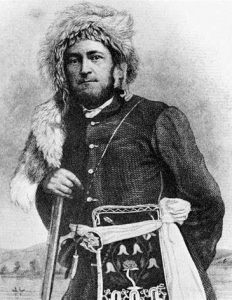 Many people who love the era of the Cowboys and Indians, also find themselves intrigued by the Mountain Men. These men were the epitome of the “wild” west. The Mountain Men were often what many might call “social rejects,” because they lived in the wilderness, hunted and fished to sustain themselves, and were often trappers who sold their furs to supplement their living. All that seems rather normal, but they were also reclusive, and often had long hair and a bushy beard. I suppose that many people would think that our opinion of the mountain men was discriminatory, but we have always had some concerns over those who were so very different. Maybe we even associated the mountain men with lawlessness. They often lived in the wilderness, because the were non-conformists when it came to the law. It wasn’t that they wanted to rob banks and kill people, but rather that they wanted to be free to live their lives the way they saw fit, without all the rules and regulations of society.
Many people who love the era of the Cowboys and Indians, also find themselves intrigued by the Mountain Men. These men were the epitome of the “wild” west. The Mountain Men were often what many might call “social rejects,” because they lived in the wilderness, hunted and fished to sustain themselves, and were often trappers who sold their furs to supplement their living. All that seems rather normal, but they were also reclusive, and often had long hair and a bushy beard. I suppose that many people would think that our opinion of the mountain men was discriminatory, but we have always had some concerns over those who were so very different. Maybe we even associated the mountain men with lawlessness. They often lived in the wilderness, because the were non-conformists when it came to the law. It wasn’t that they wanted to rob banks and kill people, but rather that they wanted to be free to live their lives the way they saw fit, without all the rules and regulations of society.
One such mountain man, was Joe Meek, who was born in Virginia in 1810. Meek was a friendly and relentlessly good-humored young man. Unfortunately, Meek did not have a the same interest in school, that he did to be a friendly, funny guy. In reality, his biggest problem was that he had too much energy to sit still and learn. After finally giving up on schooling, at 16 years old, Meek moved west to join two of his brothers in Missouri. Meek later found a need to read and write, and so taught himself, but his spelling and grammar were said to be “highly original” throughout his life.
In early 1829, Meek joined William Sublette’s ambitious expedition to begin fur trading in the Far West. This was the perfect lifestyle for Meek, and he found himself flourishing. Meek traveled throughout the West for the next decade, thoroughly enjoying the adventure and independence of the mountain man life. Meek was an average man, standing 6 feet 2 inches tall. He wore a heavy beard, and became a favorite character at the annual mountain-men rendezvous, where he regaled his companions with humorous and often exaggerated stories of his wilderness adventures. Meek, who was a well known grizzly hunter, claimed he liked to “count coup” on the dangerous animals before killing them, a variation on a Native American practice in which they shamed a live human enemy by tapping them with a long stick. Meek also claimed to have wrestled an attacking grizzly with his bare hands, before finally sinking a tomahawk into its brain. I suppose it might have been a tall tale, but more than one mountain man hs fought a bear. Some have won, and some have not had the same outcome…sadly.
Meek may have been a misfit in society, but he had good relations with many Native Americans, and in fact, he married three Indian women during his lifetime, including the daughter of a Nez Perce chief. Still, that good relationship didn’t prevent him from getting into some squabbles with the tribes. Many of the Indians didn’t like the incursion of the mountain men into their territories, and periodically, things got hostile. In the spring of 1837, Meek was nearly killed by a Blackfeet warrior who was taking aim with his bow while Meek tried to reload his Hawken rifle. Luckily for Meek, the warrior dropped his first arrow while drawing the bow, and the mountain man had time to reload and shoot.
Finally, in 1840, Meek saw that the golden era of the free trappers was ending. He decided that it was time for a “career change.” Meek and another mountain man, along with Meek’s third wife guided one of the first wagon trains to cross the Rockies on the Oregon Trail. Once there, Meek settled in the lush Willamette Valley of western Oregon, became a farmer, and actively encouraged other Americans to join him. He could see that  times were changing. In 1847, Meek led a delegation to Washington DC, asking for military protection from Indian attacks and territorial status for Oregon. After the long journey, Meek arrived in Washington DC “ragged, dirty, and lousy.” Nevertheless, he became something of a celebrity in the capitol…maybe a little bit like “Crocodile Dundee.” Meek was a novelty, and the Easterners relished the boisterous good humor Meek showed in proclaiming himself the “envoy extraordinary and minister plenipotentiary from the Republic of Oregon to the Court of the United States.” The trip was quite successful, and Congress responded by making Oregon an official American territory and Meek became a US marshal.
times were changing. In 1847, Meek led a delegation to Washington DC, asking for military protection from Indian attacks and territorial status for Oregon. After the long journey, Meek arrived in Washington DC “ragged, dirty, and lousy.” Nevertheless, he became something of a celebrity in the capitol…maybe a little bit like “Crocodile Dundee.” Meek was a novelty, and the Easterners relished the boisterous good humor Meek showed in proclaiming himself the “envoy extraordinary and minister plenipotentiary from the Republic of Oregon to the Court of the United States.” The trip was quite successful, and Congress responded by making Oregon an official American territory and Meek became a US marshal.
Strangely, considering his anti-social beginnings, Meek returned to Oregon and became heavily involved in politics, eventually helping to found the Oregon Republican Party. He later retired to his farm, where he died on June 20, 1875 at the age of 65.
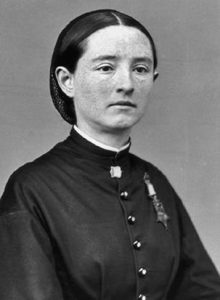 These days, we are all used to having a female doctor taking care of us. Those who haven’t are, nevertheless, not opposed to it. Others really don’t want a male doctor. It’s not a gender issue exactly, but there are women who just don’t feel comfortable with a male doctor, and men who don’t feel comfortable with a female doctor. We might have thought that this would not still be an issue all these years later, but it can be. As long as people are uncomfortable with their bodies, this might be the case.
These days, we are all used to having a female doctor taking care of us. Those who haven’t are, nevertheless, not opposed to it. Others really don’t want a male doctor. It’s not a gender issue exactly, but there are women who just don’t feel comfortable with a male doctor, and men who don’t feel comfortable with a female doctor. We might have thought that this would not still be an issue all these years later, but it can be. As long as people are uncomfortable with their bodies, this might be the case.
In the 1800s, however, this was not just an issue of discomfort, it was just not done. Mary E Walker was born in 1832, in Oswego Town near Oswego, New York. She was never one, to “hide her light,” but rather always stood out in a crowd. Even as a child, she was distinguished for her strength of mind and her decision of character. She grew into a very independent woman. Mary wanted to be useful. She had no desire to sit at home and be “just a housewife.” Mary was a feminist before most people knew what that was. She always had great energy, and in her early years, she wore bloomers, the pantaloon style garb of the radical feminists of the age. She decided to go to medical school, and when she graduated in 1855, she was the only female in her class from Syracuse Medical College. After graduation, she became one of the few women physicians in the country.
When the Civil War began in 1861, Dr Walker, who was 29 years old by then, journeyed to Washington DC and applied for an appointment as an Army surgeon. Of course, the Medical Department was…shocked, to put it mildly, and they quickly rejected her…with considerable verbosity. “A woman’s place is in the home,” or “No one will go to a woman doctor!” Dr Walker was not a woman who could be so easily discouraged. She stayed in Washington, and even served as an unpaid volunteer in various camps. Who would do that, and how did she survive without pay. Then, when the patent office was converted into a hospital, Walker served as assistant surgeon…again, without pay. During her time in the patent-office-turned-hospital, she was instrumental in establishing an organization that aided needy women who came to Washington to visit wounded relatives. It was a need that no one really thought about until she did, and it was probably reminiscent on the modern-day Ronald McDonald House.
As good as she was, Walker was not immune to considerable amounts of abuse over her persistent demands to be made a surgeon. Still, they could not dispute the fact that she also earned considerable respect for her many good works. It was about this time that she decided to abandon the bloomers and adopt a modified version of male attire, with a calf length skirt worn over trousers. She kept her hair relatively long and curled 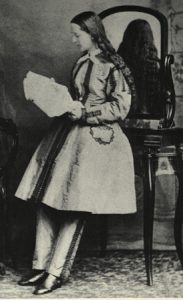 so that anyone could know she was a woman. While she wore a modified version of men’s clothes, she wanted everyone to know that she was a woman. She would not mask her talents by pretending to be a man.
so that anyone could know she was a woman. While she wore a modified version of men’s clothes, she wanted everyone to know that she was a woman. She would not mask her talents by pretending to be a man.
Finally, in November 1862, Dr Mary E Walker presented herself at the Virginia headquarters of MG Ambrose Burnside, and was taken on as a field surgeon. She was still a volunteer, but she was a titled surgeon. She treated the wounded at Warrenton and in Fredericksburg in December 1862. Almost a year later, she was in Chattanooga, Tennessee, tending the casualties of the battle of Chickamauga. After the battle, she again requested a commission as an Army doctor, such a simple thing after her years of loyal service, I would think. In September 1863, MG George H Thomas appointed her as an assistant surgeon in the Army of the Cumberland, assigning her to the 52nd Ohio Regiment. Finally, she had her commission. Now, many stories were told of her bravery under fire. Suddenly, it was ok to talk about just how incredible she was.
Sadly, she served with the 52nd Ohio Regiment for only a short time. In April 1864, Walker was captured by Confederate troops. She had stayed behind to tend wounded following a Union retirement. The Confederates charged her with being a spy and arrested her. The spy accusation came about as a result of her male attire. They said it constituted the principal evidence against her. Dr Walker spent the next four months in various prisons, being subjected to much abuse for her “unladylike” occupation and attire, until she was exchanged for a Confederate surgeon in August 1864.
In October of the same year, the Medical Department granted Dr Walker a contract as an acting assistant surgeon. Finally, 3 years after she first showed up on their doorstep she was given the rank and pay she deserved. Still, despite her requests for battlefield duty, she was not sent into the field again. She spent the rest of the war as superintendent at a Louisville, Kentucky, female prison hospital and a Clarksville, Tennessee orphanage. After she was released from her government contract at the end of the war, Walker lobbied for a brevet promotion to major for her services. Typically, Secretary of War Stanton would not grant the request. Finally, President Andrew Johnson asked for another way to recognize her service. A Medal of Honor was presented to Dr Walker in January 1866. She wore it every day for the rest of her life. She continued in the women’s rights movement and also crusaded against immorality, alcohol and tobacco, and for clothing and election reform. One of her more unusual positions was that there was no need for a women’s suffrage act, as women already had the vote as American citizens. Her taste in clothes never changed, and caused her frequent arrests on such charges as impersonating a man. At one trial, she asserted her right to, “Dress as I please in free America on whose tented fields I have served for four years in the cause of human freedom.” The judge 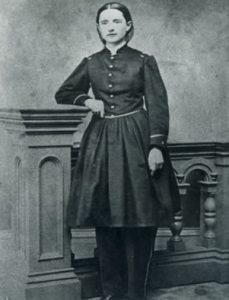 dismissed the case and ordered the police never to arrest Dr Walker on that charge again. She left the courtroom to hearty applause.
dismissed the case and ordered the police never to arrest Dr Walker on that charge again. She left the courtroom to hearty applause.
In 1916, Congress revised the Medal of Honor standards to include only actual combat with an enemy. Several months later, in 1917, the Board of Medal Awards, after reviewing the merits of the awardees of the Civil War awards, ruled Dr Walker’s medal, as well as those of 910 other recipients, as unwarranted and revoked them. It was an insult of the highest degree, and even after her death on February 21, 1919 at the age of 86, it was not to be forgotten. Nearly 60 years after her death, one of her descendants urged the Army Board for Correction of Military Records to review the case. On June 19, 1977, Army Secretary Clifford Alexander approved the recommendation to restore the Medal of Honor to Dr Mary E Walker. It was the right thing to do. Walker remains the sole female recipient of the Medal of Honor.
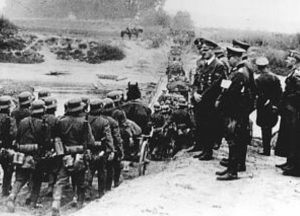 While Germany was not able to bring home the victory in World War II, they were a formidable enemy early in the war. On April 9, 1940, Nazi Germany launched an invasion into Norway. The initial attack was successful, and the Nazis captured several strategic points on the Norwegian coast. Hitler didn’t care that Norway had declared neutrality at the outbreak of World War II. Hitler wanted to rule the world and Norway was part of what he wanted.
While Germany was not able to bring home the victory in World War II, they were a formidable enemy early in the war. On April 9, 1940, Nazi Germany launched an invasion into Norway. The initial attack was successful, and the Nazis captured several strategic points on the Norwegian coast. Hitler didn’t care that Norway had declared neutrality at the outbreak of World War II. Hitler wanted to rule the world and Norway was part of what he wanted.
During the preliminary phase of the invasion, Norwegian fascist forces under Vidkun Quisling acted as a so-called “fifth column” for the German invaders, seizing Norway’s nerve centers, spreading false rumors, and occupying military bases and other locations. They were the invaders from within. 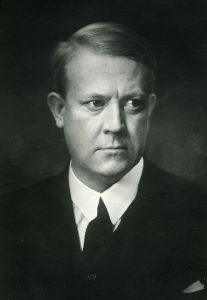 Quisling agreed with Hitler concerning the “Jewish problem” and became the leader of Norway during the Nazi occupation. Prior to that Quisling served as the Norwegian minister of defense from 1931 to 1933, and in 1934 he left the ruling party to establish the Nasjonal Samling, or National Unity Party, which was an imitation of Adolf Hitler’s Nazi Party.
Quisling agreed with Hitler concerning the “Jewish problem” and became the leader of Norway during the Nazi occupation. Prior to that Quisling served as the Norwegian minister of defense from 1931 to 1933, and in 1934 he left the ruling party to establish the Nasjonal Samling, or National Unity Party, which was an imitation of Adolf Hitler’s Nazi Party.
Norway’s declaration of neutrality didn’t do them much good when their own minister of defense was a traitor. Norway’s declared neutrality at the outbreak of World War II, was simply a small stumbling block in the plan Nazi Germany had. Hitler regarded the occupation of Norway a strategic and economic necessity. In the spring of 1940, Vidkun Quisling met with Nazi command in Berlin to plan the German conquest of his country. The Norwegian people have no warning on April 9th, when the combined German forces attacked, and by June 10th Hitler had conquered Norway and driven all Allied forces from the country.
Being the head of the only political party permitted by the Nazis didn’t do Quisling 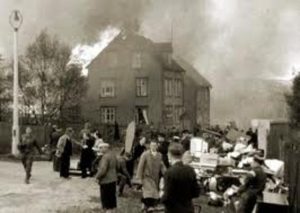 any good either. The people hated him, and opposition to him in Norway was so great that he couldn’t formally establish his puppet government in Oslo until February 1942. Nevertheless, the regime he set up under the authority of his Nazi commissioner, Josef Terboven, was a repressive regime that was merciless toward those who defied it. There was not peace for either side in those years. Norway’s resistance movement soon became the most effective in all Nazi-occupied Europe, and Quisling’s authority rapidly failed. After the German surrender in May 1945, Quisling was arrested, convicted of high treason, and shot. He was so hated that from his name comes the word quisling, meaning “traitor” in several languages.
any good either. The people hated him, and opposition to him in Norway was so great that he couldn’t formally establish his puppet government in Oslo until February 1942. Nevertheless, the regime he set up under the authority of his Nazi commissioner, Josef Terboven, was a repressive regime that was merciless toward those who defied it. There was not peace for either side in those years. Norway’s resistance movement soon became the most effective in all Nazi-occupied Europe, and Quisling’s authority rapidly failed. After the German surrender in May 1945, Quisling was arrested, convicted of high treason, and shot. He was so hated that from his name comes the word quisling, meaning “traitor” in several languages.
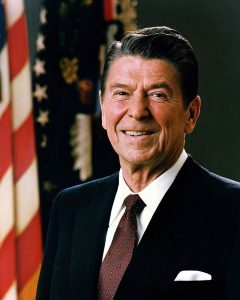 Many people would agree that one of the greatest presidents the United States ever had was Ronald Reagan. He was not what we would consider a career politician, and in fact, most would knw him as an actor long before he was a politician. Nevertheless, after spending time as the President of the Screen Actors’ Guild, where he fought against Communist influence on the screen, Ronald Reagan was elected governor of California in 1966. He then became president in 1980, and the rest, as they say is history, but it is not the end.
Many people would agree that one of the greatest presidents the United States ever had was Ronald Reagan. He was not what we would consider a career politician, and in fact, most would knw him as an actor long before he was a politician. Nevertheless, after spending time as the President of the Screen Actors’ Guild, where he fought against Communist influence on the screen, Ronald Reagan was elected governor of California in 1966. He then became president in 1980, and the rest, as they say is history, but it is not the end.
Ronald Reagan would prove to be a very strong person in many areas of his life…some we know of, and some, maybe not…or at least, I didn’t. After college, where Reagan was an average student, and basically considered a “jack of all trades,” he did some work in radio and such until deciding to enlist in the Army Enlisted Reserve. He was commissioned a second lieutenant in the Officers’ Reserve Corps of the Cavalry on May 25, 1937. On April 18, 1942, Reagan was ordered to active duty, but because of poor eyesight, he was classified for limited service only, which excluded him from serving overseas. His first assignment was at the San Francisco Port of Embarkation at Fort Mason, California, as a liaison officer of the Port and Transportation Office. Upon the approval of the Army Air Forces (AAF), he applied for a transfer from the cavalry to the AAF on May 15, 1942, and was assigned to AAF Public Relations and subsequently to the First Motion Picture Unit (officially, the 18th AAF Base Unit) in Culver City, California. On January 14, 1943, he was promoted to first lieutenant and was sent to the Provisional Task Force Show Unit of “This Is The Army” at Burbank, California. He returned to the First Motion Picture Unit after completing this duty and was promoted to captain on July 22, 1943. While he did not serve in combat, President Reagan was shot. Most of us know that President Reagan survived an assassination attempt on March 30, 1981, when he and his press secretary James Brady were both shot. Also hit by gunfire from would-be assassin John Hinckley Jr outside the Washington Hilton Hotel, were Washington police officer Thomas Delahanty and Secret Service agent Tim McCarthy. President Reagan was “close to death” when he arrived at George Washington University Hospital. He was stabilized in the emergency room, then underwent emergency exploratory surgery. He recovered from his gunshot wound, and was released from the hospital on April 11, becoming the first serving US president to survive being shot in an assassination attempt. President Reagan became very popular after the attempt of his life, with the polls indicating his approval rating to be around 73 percent.
For his part, Reagan believed that God had spared his life so that he “might go on to fulfill a higher purpose.” That is true in my opinion, but it was not the first time Ronald Reagan’s life had been placed at risk. President Reagan attended Dixon High School, where he developed interests in acting, sports, and storytelling, but his first job involved working as a lifeguard at the Rock River in Lowell Park in 1927. He was a life guard there for six years, and during that time, Reagan performed 77 rescues. While much of the rest of his career was highly  public, and well known by most people, this little tidbit was rather hidden in the archives of his life. I suppose many people thought that his job as a lifeguard was a minor role within the many roles he played in his lifetime, but I doubt if the 77 people whose lives he saved as a lifeguard would consider it to be such a minor role. If you have ever been saved from drowning…and I have…you know that you will never forget that person who saved you. I never knew my rescuer’s name, but to this day, I can see her face. I was a girl of about 10 or 12 maybe, and had no training in swimming, but I had achieved the great height of 5 feet, and thought that meant I could swim in the 5 foot area of the pool, not considering that 5 feet was at the top of my head. Thank God for the girl swimming by, who pushed me to the side of the pool. Needless to say, I taught myself to swim after that, and before summer’s end I had passed my swimming test at the pool. What President Reagan did for those 77 people, was as heroic as any soldier. A flailing victim in danger of drowning can take down their would be rescuer, and then both would likely drown. It takes a special person to put their life at risk to save another, and as in many other areas of his life, President Reagan was a true hero.
public, and well known by most people, this little tidbit was rather hidden in the archives of his life. I suppose many people thought that his job as a lifeguard was a minor role within the many roles he played in his lifetime, but I doubt if the 77 people whose lives he saved as a lifeguard would consider it to be such a minor role. If you have ever been saved from drowning…and I have…you know that you will never forget that person who saved you. I never knew my rescuer’s name, but to this day, I can see her face. I was a girl of about 10 or 12 maybe, and had no training in swimming, but I had achieved the great height of 5 feet, and thought that meant I could swim in the 5 foot area of the pool, not considering that 5 feet was at the top of my head. Thank God for the girl swimming by, who pushed me to the side of the pool. Needless to say, I taught myself to swim after that, and before summer’s end I had passed my swimming test at the pool. What President Reagan did for those 77 people, was as heroic as any soldier. A flailing victim in danger of drowning can take down their would be rescuer, and then both would likely drown. It takes a special person to put their life at risk to save another, and as in many other areas of his life, President Reagan was a true hero.
 Every security detail prides itself in being able to stop any attack that might come toward the person or persons they are assigned to protect. Allowing a threat, any threat…be it a serious threat, or a minor prank…to get by the security check points, is seriously embarrassing and can be very dangerous. Never was this more widely publicized than on May 28, 1987, in Moscow.
Every security detail prides itself in being able to stop any attack that might come toward the person or persons they are assigned to protect. Allowing a threat, any threat…be it a serious threat, or a minor prank…to get by the security check points, is seriously embarrassing and can be very dangerous. Never was this more widely publicized than on May 28, 1987, in Moscow.
Early on that morning, a young man named Matthias Rust, a 19 year old amateur pilot from West Germany, took off from Helsinki, Finland and headed east. Rust flew his small Cessna airplane through 400 miles of Soviet airspace, somehow undetected, and landed it in Red Square by the Kremlin. The stunt was an immense embarrassment to the Soviet government and military…to say the least. I would think that “heads would roll” figuratively speaking. Red Square should be some of the most seriously protected airspace in the world, but here a 19 year old kid blew through the protections they had in place, and brazenly landed his small plane right in the middle of Red Square!!
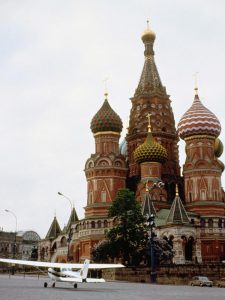
Rust was not a known troublemaker. His mother said that he was a “quiet young man with a passion for flying.” He had no known political or social agenda when he took off from the international airport in Helsinki and headed for Moscow, so what was the purpose of his flight and subsequent illegal landing. He entered Soviet airspace, but was either undetected or ignored as he pushed farther and farther into the Soviet Union, but how was that possible. He arrived over Moscow, early that morning, circled Red Square a few times, and then simply landed…just a few hundred yards from the Kremlin. The people in the square, mostly curious onlookers and tourists, believed that Rust was part of an air show. They quickly surrounded him, probably wanting his autograph. Then, very quickly, Rust was arrested and taken to jail. The charges were severe. He was tried for violating Soviet airspace and sentenced to prison. I don’t know if the charge would have normally gained him a longer prison sentence, or if they took pity on him because of his age, but Rust served 18 months before being released…probably a relatively short sentence in retrospect.
The repercussions in the Soviet Union, however, were immediate. Soviet leader Mikhail Gorbachev fired his minister of defense, and the entire Russian military was humiliated by Rust’s flight into Moscow. The United 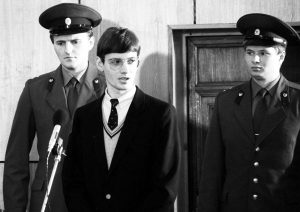 States officials didn’t make matters any easier either. They had a field day with the event. One American diplomat in the Soviet Union joked, “Maybe we should build a bunch of Cessnas.” The Soviet officials were not amused. Just four years earlier, the Soviets had been harshly criticized for shooting down a Korean Airlines passenger jet that veered into Russian airspace. Now, being able to stop one teenager’s “invasion” of the country, the Soviets became the laughingstocks. One Russian spokesperson bluntly declared, “You criticize us for shooting down a plane, and now you criticize us for not shooting down a plane.” No matter how you look at it, the situation was, to say the least, militarily embarrassing.
States officials didn’t make matters any easier either. They had a field day with the event. One American diplomat in the Soviet Union joked, “Maybe we should build a bunch of Cessnas.” The Soviet officials were not amused. Just four years earlier, the Soviets had been harshly criticized for shooting down a Korean Airlines passenger jet that veered into Russian airspace. Now, being able to stop one teenager’s “invasion” of the country, the Soviets became the laughingstocks. One Russian spokesperson bluntly declared, “You criticize us for shooting down a plane, and now you criticize us for not shooting down a plane.” No matter how you look at it, the situation was, to say the least, militarily embarrassing.
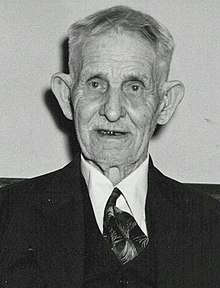
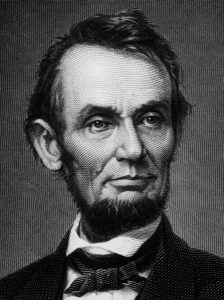 Imagine being a witness to a part of history. Of course, we all are. We witness our part of history, because history happens all around us. It’s just that some events are more. More what you might ask. More devastating, more tragic, more exciting, just more. One such event was the assassination of President Lincoln. I can’t begin to imagine what it would have been like to go out for a night at the theater only to have the evening shattered be gunfire…and then to look up and see that your President was slumped over, bleeding, and dying. Now imagine you were just a child at the time.
Imagine being a witness to a part of history. Of course, we all are. We witness our part of history, because history happens all around us. It’s just that some events are more. More what you might ask. More devastating, more tragic, more exciting, just more. One such event was the assassination of President Lincoln. I can’t begin to imagine what it would have been like to go out for a night at the theater only to have the evening shattered be gunfire…and then to look up and see that your President was slumped over, bleeding, and dying. Now imagine you were just a child at the time.
That was the situation Samuel Seymour found himself in on April 14, 1865. On April 14, 1865, Seymour was five years old, when his godmother, who was the wife of his father’s employer took him to see Our American Cousin at Ford’s Theater in Washington DC. They were sitting in the balcony across the theater from the Presidential box. Everyone knew President Lincoln. I don’t know how star struck people got back then. Not nearly as much as today, but everyone knew him. A while later, says Seymour, “All of a sudden a shot rang out…and someone in the President’s box screamed. I saw Lincoln slumped forward in his seat.” Suddenly, John Wilkes Booth jumped from the box to the stage. What five year old boy wouldn’t remember those two events. Of course, Seymour didn’t understand what had happened to President Lincoln, 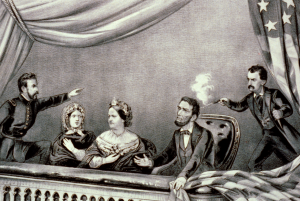 but he was very concerned for Booth, who broke his leg in the jump. He was just a child.
but he was very concerned for Booth, who broke his leg in the jump. He was just a child.
As a child, Seymour was the youngest person in the theater. Most, if not all of the people there were adults. Two months before his death, Seymour appeared on the February 9, 1956, broadcast of the CBS TV panel show “I’ve Got a Secret.” Seymour was hurt in a fall prior to the show, and the show’s producers had urged Seymour to postpone his appearance on the show. Seymour’s doctor left the choice up to Seymour, Seymour chose to go on. During the panelists correctly guessed that Seymour witnessed the assassination of Lincoln. Seymour died on April 12, 1956, and with that, the last witness to Lincoln’s assassination was gone.

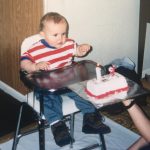 My nephew, Weston Moore decided last year, after his high school graduation, to take some time off before going to college. He wanted to work, save up some money, and buy a different car. He also planned to save up some money for when he goes back to school. At this point, he is getting close to having enough money for the car, but as we all know, things have changed today’s world. with the Coronavirus Pandemic, people are being told to stay at home, businesses are closing down, only essential workers are allowed to go to work…all in an effort to stop the spread of this virus. That said, Weston still has a job, but not many hours.
My nephew, Weston Moore decided last year, after his high school graduation, to take some time off before going to college. He wanted to work, save up some money, and buy a different car. He also planned to save up some money for when he goes back to school. At this point, he is getting close to having enough money for the car, but as we all know, things have changed today’s world. with the Coronavirus Pandemic, people are being told to stay at home, businesses are closing down, only essential workers are allowed to go to work…all in an effort to stop the spread of this virus. That said, Weston still has a job, but not many hours.
In this time, Weston and his family are thankful that he was not away at college, especially since the colleges are mostly closed. Weston is still living at home and his family are all thankful to be together in this difficult time. Thinking back on his graduation, he and his family are glad he graduated last year, because with the pandemic, no school is assured of the ability to hold their graduation ceremonies or parties.
Many things are different now, and it is quite likely that there will be no big gathering for Weston’s birthday. Instead it will be just him, his brother, Easton; and their parents, Machelle and Steve. His mom decides to get a cake last week so she would have one, in case she couldn’t get out as the day drew closer. At this point, they 
 have been hunkering down at the house, leaving only when necessary, and concentrating on staying well. Things are always subject to change…instantly in times of a great pandemic, like we are in the midst of, but Weston always has a great attitude, and that can make his one person who will lift every one else’s spirits. That kind of person is exactly what we need in trying time, and I’m glad that the Moore family has just such a person. These are strange times. Today is Weston’s 20th birthday. Where have the years gone. Happy birthday Weston!! Have a great day!! We love you!!
have been hunkering down at the house, leaving only when necessary, and concentrating on staying well. Things are always subject to change…instantly in times of a great pandemic, like we are in the midst of, but Weston always has a great attitude, and that can make his one person who will lift every one else’s spirits. That kind of person is exactly what we need in trying time, and I’m glad that the Moore family has just such a person. These are strange times. Today is Weston’s 20th birthday. Where have the years gone. Happy birthday Weston!! Have a great day!! We love you!!

